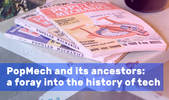[Учебный процесс в IT, История IT, Научно-популярное, Управление медиа] PopMech and its ancestors: a foray into the history of tech
Автор
Сообщение
news_bot ®
Стаж: 7 лет 9 месяцев
Сообщений: 27286
Many of us grew up reading a classic, that was a staple of many home libraries. However, it doesn’t seem to be as prominent as it once was. To understand the ongoing shift in tech coverage, we need to explore its roots.
Pic by Adam Kliczek. Wikipedia (CC-BY-SA-3.0)Leisure for the educatedNewspapers first emerged in the 17th century as successors to avvisi, medieval newsletters with political and trade-related content. Just like avvisi, they only featured the most important news, and despite the unimaginably low literacy rates at the time, the public was genuinely interested in the format.The developed parts of Europe were flooded by all sorts of newspapers, fighting for their share of the market. As time went by, scientific matters were mentioned on the pages of high-circulation gazettes, but, to the best of my knowledge, it wasn’t the focus of any particular newspaper until the 19th century.Popular science magazines, on the other hand, were abundant at the time. Though they didn’t look like the magazines of today, and their readership was, too, drastically different. These were mostly medium-sized books up to 400 pages long that featured essays written for a highly educated, predominantly upper class audience. They were accessible by today’s standards, but, perhaps, a bit less so back then.Magazines provided a wide variety of content — from explanations of scientific principles to travelogues and even fiction. They were published all around the world — in Britain, Italy, the US, and Russia.
18th century was marked by a steady process of science democratisation. Once the printing technology was there, science magazines went mainstream, truly mainstream.The publishing boom
The publishing boomThe magazine culture as we know it began taking shape in the middle of the 19th century. Circulation went up as page counts and prices went down. Some of the best known popular science magazines started up back then. Scientific American, which eventually came to feature the works of Roosevelt and Einstein, first hit the shelves on August of 1845. Nature, one of the most reputable science magazines, began circulation in November of 1869. Another staple of science periodicals — Popular Science— was born in 1872.Throughout the 18th century, science was still often called ‘natural philosophy’ — and the magazines of the time make it apparent why. They were read primarily for contemplation, by an audience with a mostly theoretical interest in science. And as this audience changed, so did the content of the magazines.Middle-class people’s relationship with science was more practical. They wanted to apply it in real life. And that’s when early tech journalism was born. Train and mechanics magazines flooded the market.
You’d be surprised at how many train enthusiasts there were back then, but it’s true. Trains were an exciting technology that people actually encountered in their daily lives.
In turn, the Mechanics’ Magazine, first published in 1823, was the one that showcased the electromechanical inventions of the day, and can be treated as a prime example of ancestors of the modern tech press. It featured schematics from the latest patents, and reports from major industry events, just like the magazines of today. It is also famous for publishing one of the earliest known popular explanations of photography. Magazines such as this one and the English Mechanic paved the way for early 20th century technology periodicals.The 116 years of PopMech18th century science concerned scientists themselves, the elite and not a lot of other people. Theology was considered to be the queen of sciences, while other disciplines played second flute to it. Then came the industrial revolution and the popularisation of tech. Progress was speeding up, and the average person couldn’t help but notice the changes — magazines took the initiative in introducing the masses to this sort of market.
Pic by Dollar Gill (Unsplash license)Popular Mechanics itself came about in 1902, at the height of the Second Industrial revolution. As science impacted people’s daily lives in increasingly direct ways, there was a need for a truly popular tech publication, and Popular Mechanics’ early tagline — “Written So You Can Understand It” — reflects exactly that. For many people, it was the magazine that got them into tech. While there were other such magazines at the time — chiefly, periodicals aimed at electrical engineering enthusiasts and, later, the amateur radio market.
Being one of the longest-running magazines in history, it can tell us a lot about the changes our society has gone through in the past century. Here are some of the most interesting and significant predictions and highlights from the magazine’s back catalogue:
1904: Jules Verne publishes an article, predicting the military use of submarines.1915: Popular Mechanics explains the military use of gas in WW1.1920s: The magazine publishes instructions for a number of magic tricks, leading to an intervention from none other than Houdini himself.1932: Winston Churchill predicts the use of nuclear power plants.1942: Glenn M. Martin, one of the most influential people in the history of American aviation, outlines his vision of long-haul jumbo jets.1959: The magazine explores the principles behind supersonic flight and weighs in on the moon landing race.1965: A feature on integrated circuits predicts the Walkman and home video cameras.1974: The magazine builds a case for computerised vehicles.1989: The magazine publishes an in-depth look into the recently revealed Lockheed F-117.1998: Smart landlines used to be a thing. Popular Mechanics review “Screen Phones” to help you decide if they are worth it.2001: The magazine launched an investigation into popular 9/11 conspiracy theories, subsequently publishing a book debunking them.2009: The magazine’s archive is digitised and made available on Google Books.To this day, Popular Mechanics remains a classic. It continues bringing technology to children and adults around the world. But it sort of drifted into the background of the tech press scene. Why is that?Well, that was supposed to eventually happen.The changing face of tech journalismNow tech permeates all levels of society — including people with no genuine interest in its inner workings. Looking at the changing style of popmech articles, you could see how the editors shifted its focus from DIY enthusiasts to consumers. One may even argue that over the past ten years, the term ‘tech journalist’ itself has become borderline derogatory. But PopMech, and the magazines like it, are still alive and well.If you ever feel nostalgic, you can just browse its publicly available archives. If not for educational purposes, then to laugh at old advertisements like this one.Further reading:
- Everything you always wanted to know about photographic memory, amnesia and false memories
- Getting Better at Understanding Academic Papers: a Brief Guide for Beginners (Part 1, Part 2)
- All gain, no pain — learning with the Flashcard method
===========
Источник:
habr.com
===========
Похожие новости:
- [Математика, Читальный зал, Научно-популярное, Игры и игровые приставки] Географические развлечения
- [Программирование, Конференции, Карьера в IT-индустрии, Учебный процесс в IT] Бесплатные онлайн-мероприятия по разработке (14 октября — 20 октября)
- [Управление персоналом, Научно-популярное, Здоровье, Удалённая работа] Выгорание может настигнуть на работе, вне работы, без работы
- [Научно-популярное, Транспорт] Карбюраторы мотоциклетного типа. Главная дозирующая система
- [Программирование, Беспроводные технологии, Разработка систем связи, Гаджеты, Научно-популярное] Определяем направление на аэропорт с помощью RTL-SDR и GNU Radio
- [Алгоритмы, Математика, Научно-популярное] Исследователи смогли преодолеть барьер в улучшении решения задачи коммивояжера
- [Будущее здесь, Космонавтика, Научно-популярное, Транспорт] Лунная программа НАСА «Артемида». Почему всё не так?
- [Криптография, История IT, Научно-популярное, Старое железо] Gerät 32620: немецкое устройство для организации шпионских номерных станций (перевод)
- [История IT, Разработка под Windows] Откуда в Windows взялись функции BEAR, BUNNY и PIGLET? (перевод)
- [Законодательство в IT, Контекстная реклама, Учебный процесс в IT] ФАС запретила рекламу в электронных дневниках курских школьников
Теги для поиска: #_uchebnyj_protsess_v_it (Учебный процесс в IT), #_istorija_it (История IT), #_nauchnopopuljarnoe (Научно-популярное), #_upravlenie_media (Управление медиа), #_itmo_university, #_popsci, #_media, #_scientific_journals, #_tech_blogs, #_history_of_it, #_blog_kompanii_universitet_itmo (
Блог компании Университет ИТМО
), #_uchebnyj_protsess_v_it (
Учебный процесс в IT
), #_istorija_it (
История IT
), #_nauchnopopuljarnoe (
Научно-популярное
), #_upravlenie_media (
Управление медиа
)
Вы не можете начинать темы
Вы не можете отвечать на сообщения
Вы не можете редактировать свои сообщения
Вы не можете удалять свои сообщения
Вы не можете голосовать в опросах
Вы не можете прикреплять файлы к сообщениям
Вы не можете скачивать файлы
Текущее время: 28-Ноя 09:02
Часовой пояс: UTC + 5
| Автор | Сообщение |
|---|---|
|
news_bot ®
Стаж: 7 лет 9 месяцев |
|
|
Many of us grew up reading a classic, that was a staple of many home libraries. However, it doesn’t seem to be as prominent as it once was. To understand the ongoing shift in tech coverage, we need to explore its roots.  Pic by Adam Kliczek. Wikipedia (CC-BY-SA-3.0)Leisure for the educatedNewspapers first emerged in the 17th century as successors to avvisi, medieval newsletters with political and trade-related content. Just like avvisi, they only featured the most important news, and despite the unimaginably low literacy rates at the time, the public was genuinely interested in the format.The developed parts of Europe were flooded by all sorts of newspapers, fighting for their share of the market. As time went by, scientific matters were mentioned on the pages of high-circulation gazettes, but, to the best of my knowledge, it wasn’t the focus of any particular newspaper until the 19th century.Popular science magazines, on the other hand, were abundant at the time. Though they didn’t look like the magazines of today, and their readership was, too, drastically different. These were mostly medium-sized books up to 400 pages long that featured essays written for a highly educated, predominantly upper class audience. They were accessible by today’s standards, but, perhaps, a bit less so back then.Magazines provided a wide variety of content — from explanations of scientific principles to travelogues and even fiction. They were published all around the world — in Britain, Italy, the US, and Russia. 18th century was marked by a steady process of science democratisation. Once the printing technology was there, science magazines went mainstream, truly mainstream.The publishing boom
You’d be surprised at how many train enthusiasts there were back then, but it’s true. Trains were an exciting technology that people actually encountered in their daily lives.
 Pic by Dollar Gill (Unsplash license)Popular Mechanics itself came about in 1902, at the height of the Second Industrial revolution. As science impacted people’s daily lives in increasingly direct ways, there was a need for a truly popular tech publication, and Popular Mechanics’ early tagline — “Written So You Can Understand It” — reflects exactly that. For many people, it was the magazine that got them into tech. While there were other such magazines at the time — chiefly, periodicals aimed at electrical engineering enthusiasts and, later, the amateur radio market. Being one of the longest-running magazines in history, it can tell us a lot about the changes our society has gone through in the past century. Here are some of the most interesting and significant predictions and highlights from the magazine’s back catalogue:
=========== Источник: habr.com =========== Похожие новости:
Блог компании Университет ИТМО ), #_uchebnyj_protsess_v_it ( Учебный процесс в IT ), #_istorija_it ( История IT ), #_nauchnopopuljarnoe ( Научно-популярное ), #_upravlenie_media ( Управление медиа ) |
|
Вы не можете начинать темы
Вы не можете отвечать на сообщения
Вы не можете редактировать свои сообщения
Вы не можете удалять свои сообщения
Вы не можете голосовать в опросах
Вы не можете прикреплять файлы к сообщениям
Вы не можете скачивать файлы
Вы не можете отвечать на сообщения
Вы не можете редактировать свои сообщения
Вы не можете удалять свои сообщения
Вы не можете голосовать в опросах
Вы не можете прикреплять файлы к сообщениям
Вы не можете скачивать файлы
Текущее время: 28-Ноя 09:02
Часовой пояс: UTC + 5
